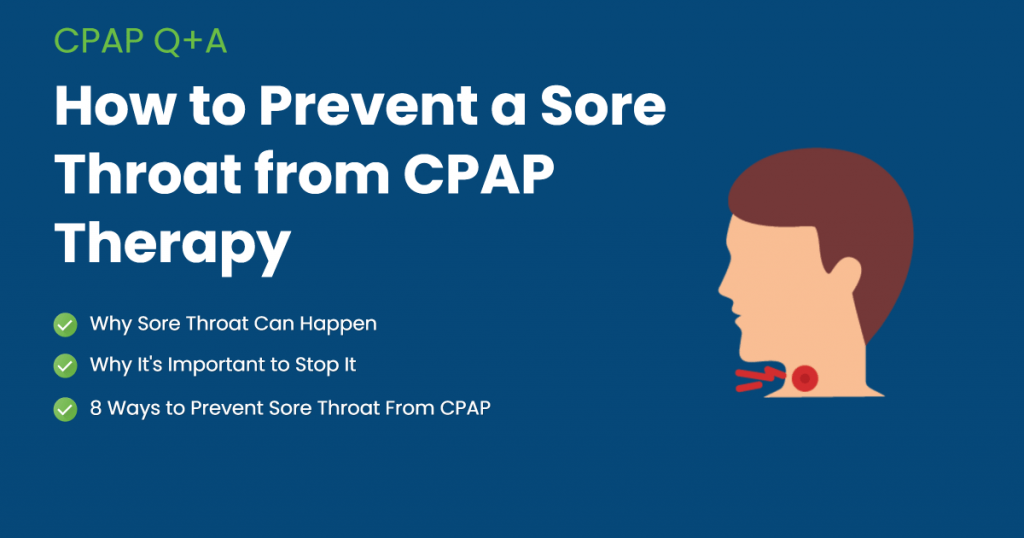
💡 Key Takeaways
- Humidification is Key: The first line of defense against a sore throat caused by CPAP is often adding a humidifier to your machine.
- Check for Mask Leaks: An air leak in your CPAP mask can lead to you breathing dry air, causing a sore throat. Make sure your mask fits well and replace worn parts.
- Consider Mask Liners: Cloth mask liners can provide a barrier between your skin and the mask, helping to prevent leaks that lead to a sore throat.
- Chinstrap for Nasal Masks: If you’re using a nasal or nasal pillow mask and experience a sore throat, a chinstrap can help keep your mouth closed, preventing dry air from escaping.
- Consult Healthcare Provider for Pressure Settings: If you’ve tried other solutions and still experience a sore throat, consult your healthcare provider for possible adjustments to your machine’s pressure settings.
Waking up with a sore throat is a common occurrence among those with undiagnosed sleep apnea, so it is understandably upsetting for many to find that they still wake up with a sore throat even after beginning treatment with a CPAP machine. Whether it’s an intermittent issue or a constant one, finding relief from a machine that constantly pushes air down your throat can feel like an uphill battle for many that are new to CPAP therapy.
Fortunately, there are a handful of strategies you can employ to eliminate sore throats caused by your CPAP machine, which we’ll be discussing later in this article.
Typically, we’ve found that adding a humidifier is a good and effective solution, but if you wear a nasal mask and use a humidifier, a chinstrap might be the right solution to end your throat irritation from CPAP. Others find that an APAP machine that adjusts to their needs on a breath-to-breath basis is a good solution, or find solace when their doctor recommends dropping their therapy pressure a bit.
If you’re struggling to keep CPAP sore throats at bay, keep reading for more insight into why CPAP makes your throat sore and actionable tips for preventing it.
Why Does CPAP Make My Throat Sore?
When not using humidification, it’s easy to imagine that the continuous pressurized stream of air provided by your CPAP machine could dry out your throat and make it sore by the end of the night. While the pressure inherently dries some people out, there are actually many who prefer CPAP without humidification, which means the air pressure can’t be solely to blame.
For other causes of CPAP sore throat, we can look to:
A Leaky CPAP Mask
If you use humidification already, an air leak in your CPAP mask will result in you breathing dry air while you sleep, which can lead to a sore throat. CPAP mask leaks are common, and typically occur due to a handful of possible reasons:
- Your Mask is Not the Right Size
- Another Mask Style is Better-Suited For You
- Your Mask Cushion Needs to Be Cleaned or Replaced
- Your Sleeping Position is Disrupting Your Mask Seal
- Your Therapy Pressure is Too High
- Your Mouth is Falling Open While You Sleep (Nasal/Nasal Pillow Masks Only)
Cold or Dry Air
Cold or arid climates and seasons have lower relative humidity and require more assistance from your CPAP humidifier to keep you comfortable. Someone who doesn’t normally use a humidifier in the summer may need one in the winter, and many people find themselves dialing up their humidity levels a notch or two come wintertime to prevent sore throats.
High Air Pressure
Your prescribed pressure is necessary to hold your airway open and clear of obstruction, but multiple factors can influence your need for a higher or lower pressure, such as:
- Weight Loss
- Starting/Stopping Smoking
- Starting/Stopping Drinking Alcohol
- Regular Exercise
- Seasonal Changes
An APAP machine that automatically adjusts to your needs on a breath-by-breath basis is a good solution for keeping up with lifestyle changes. It will only ever deliver the lowest pressure necessary for your airway to stay open and doesn’t need a doctor’s visit to recalibrate, unlike a CPAP machine.
Respiratory Illness
If you are dealing with a respiratory condition such as a sinus infection, using your CPAP machine can make you develop a sore throat or worsen the disease. While it can be tempting to skip therapy during times of illness, you almost always put yourself at more risk by not treating your sleep apnea on top of that illness. Consult your healthcare provider if you’re sick and can’t find a way to tolerate your therapy anymore.
The Downside of Not Dealing With CPAP Sore Throat
The dangers of untreated sleep apnea are many, and when you associate pain or discomfort with your CPAP machine, you’re going to be significantly less likely to use it. If you suffer through it and just hope for the best without making any change, you’re more likely to experience discomfort around swallowing, eating, and possibly even talking.
If you decide not to use your CPAP machine because it gives you a sore throat, you increase your chances of developing cardiovascular disease, type II diabetes, Alzheimer’s, and high blood pressure. It should go without saying that it’s in your best interest to find a solution below that works for you to eliminate your sore throat from CPAP for good.
8 Ways To Prevent A Sore Throat From CPAP
After identifying the reasons why using your CPAP device is giving you a sore throat, you should consider taking the following steps to prevent further CPAP throat irritation:
1. Try Humidification
Most modern CPAP machines have humidifiers built into them, but a standalone humidifier is an option for older machines without them. Humidification is typically the first line of defense when it comes to airways that are dry and irritated from CPAP. While the nose does a good job of humidifying air on its own, the increased pressure calls for increased humidity.
2. Inspect the Mask For Leaks and Replace Worn Parts
There are several reasons a mask might be leaking, including an aged or dirty cushion, loose headgear, or even your sleeping position. The first thing you should do is inspect your mask for any obvious signs of wear, and ensure that you maintain a consistent cleaning routine and replacement schedule.
If you know your mask is a good fit and your sore throat is a more recent development, it may be a good indicator that it’s time to replace your cushion or headgear to stop the leaks.
3. Consider Mask Liners
If your equipment is fresh and well-maintained yet you still experience leaks that lead to a sore throat, cloth mask liners provide a barrier between your skin and mask, giving your seal more flexibility to adapt to different sleeping positions. Many reviewers find that mask liners are “what was missing from” their therapy, and it’s not uncommon for some people to finally find their first restful night of CPAP sleep thanks to a cloth mask liner.
4. Get a Chinstrap
If you use a nasal or nasal pillow mask and experience sore throats from your CPAP, it’s likely that your mouth is falling open while you sleep. When this happens, the pressurized air escapes through your mouth, preventing the natural humidification of your nasal passages from receiving moisture from your exhalations and drying you out faster. A good CPAP chinstrap will gently support your jaw to prevent your mouth from falling open, allowing your therapy to work as intended.
5. Try a Different Mask
If you have a nasal or nasal pillow mask and don’t want to use a chinstrap, another option is to try a full face mask instead. Your pressure may be too high for your mask type or your preferred sleeping position may not be well-suited for it. Our 30-day mask trial policy ensures that you don’t get stuck with a mask you don’t like and gives you time to find the best fit for you without wasting money buying ten different masks to find the right one.
6. Replace Your Air Filter Regularly
When you aren’t regularly replacing or cleaning your air filter, you’re raising your chances of inhaling dirt, dust, and pathogens that can lead to a sore throat or even illness. If you have disposable air filters, replace them every two weeks to a month. For reusable filters, rinse them every one to two weeks and replace them every three to six months.
7. Address Air Pressure Settings
If none of the above tips have brought solace, it may be time for you to schedule a visit with your healthcare provider to discuss lowering your pressure setting or considering an APAP machine. Never adjust your pressure settings without the guidance of your healthcare provider.
8. Warm Your Airflow
Inhaling cold air is a significant contributor to sore throats from CPAP because it essentially steals moisture on its way through your respiratory system. While you’ll still have similar dryness issues, warming your air with a heated hose can make the pressure more comfortable as it becomes closer to your own body temperature, taking the edge off.
Frequently Asked Questions About CPAP Sore Throats
Can I Use My CPAP Device Without Water?
Yes. However, the machine will stop humidifying the air you breathe, which can cause dry mouth and sore throats. The air will still pass through the empty water chamber and may become slightly louder as a result.
Should I Use My CPAP If I Have a Sore Throat?
While it may be uncomfortable, it’s best that you try to continue your therapy because it will help relieve cold and flu symptoms while also ensuring you get the rest you need, leaving your immune system stronger and more capable of defending you.
Can You Get Strep Throat From a CPAP Machine?
Inherently, you cannot get strep throat from a CPAP machine. However, if you do not follow a regular cleaning routine, it is much easier to contract illnesses such as strep throat from your CPAP machine if you were recently sick.
The Bottom Line
Nobody likes being sick, but being sick because of an issue with a device that’s supposed to be improving your health is frustrating. With some careful attention and diligence, it’s possible to leave your struggle with CPAP throat irritation in the past.
By regularly inspecting, cleaning, and replacing your equipment, you protect yourself from adverse CPAP side effects such as sore throats that happen due to mask leaks.
Adding humidification can help your body tolerate the pressure from CPAP and eliminate sore throat symptoms. For those who prefer nasal or nasal pillow masks, a chinstrap to hold the mouth closed can also prevent a sore throat from CPAP. If you suffer from mask leaks that are causing your sore throat, try a cloth mask liner first, but don’t be afraid to try a new mask style either.
We hope this article was helpful and informative for you. If we didn’t mention your go-to solution for stopping CPAP sore throats in their tracks, let us know in the comment section!




